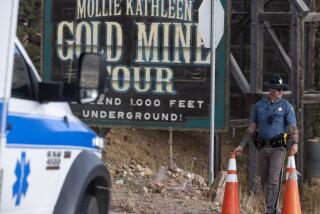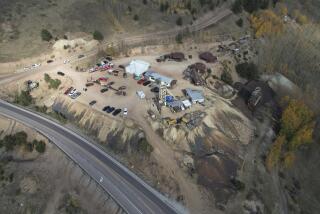Rescuers Drilling Toward 9 Trapped Pa. Coal Miners
SOMERSET, Pa. — Faint as whispers, tapping noises from deep underground signaled hope to rescuers who spent Thursday tunneling 300 feet down toward a mine shaft where nine Pennsylvania miners were trapped in a cramped chamber flooding with cold groundwater.
At nightfall, a giant truck-mounted mechanical drill rushed in from West Virginia began boring a 2 1/2-foot-wide opening deep into the dense earth. Digging the underground pathway was expected to take up to 18 hours before it could reach the subterranean air pocket where the miners were caught after they accidentally breached the wall of an abandoned mine Wednesday night, triggering a collapse of dirt and water.
The ear-splitting drone of drills and hiss of air compressors rose so loudly over the hilly western Pennsylvania countryside that crews had to use delicate seismic monitors to listen for the weakening metallic sounds from below.
Last heard late Thursday morning, the tapping from the lower depths of the Quecreek mine remained firm evidence of life to the weary rescuers and families who kept vigil in a nearby fire hall. They prayed that the machines could save their men.
“We still believe there are miners alive,” said David Hess, Pennsylvania’s secretary of environmental protection. “This is a very tricky and dangerous situation, and I don’t want to raise expectations.”
State and mining company officials said the miners were likely hemmed in inside a narrow 3-foot-high vault beneath the earth, an air pocket prone to groundwater pouring in from the open wall of the adjacent mine. Officials said that nearly 50 million gallons of water, as cold as 55 degrees and likely contaminated, lay behind the breached mine.
“It’s a very large body of water and it’s coming in at a very high rate,” said Joseph Sbaffoni of Pennsylvania’s Bureau of Deep Mine Safety.
Rescue crews manned smaller mechanical drills all day Thursday, punching holes deep into the ground and then operating air compressors to force the flooding water up to the surface at a rate of 15,000 gallons a minute.
But Hess worried openly that the rescue shaft--which had penetrated only 45 feet down by 9 p.m.--might pierce the air pockets created by the compressors and flood the chamber where the miners were trapped. “This is a very delicate operation,” Hess cautioned.
For the relatives and friends of the trapped men, it was hope enough. Long past dusk, they headed for the drilling site on a farm 100 yards off the main highway. There, they prayed and talked quietly, their faces lighted by the glare of portable spotlights that cut through the night mist.
“Something like this hits so hard in a mining town where people know each other and care about each other,” said Marlene Seese, whose father worked a lifetime in the mines and whose grandfather died of a mining injury.
The impulse to band together is now well-practiced in Somerset County, a farming community 55 miles southeast of Pittsburgh. On Sept. 11, residents were jolted by the crash of United Airlines Flight 93, which plunged into a field in nearby Shanksville. Since then, Somerset County residents have turned the site into their patriotic memorial to passengers who they believe became heroic martyrs fighting Al Qaeda hijackers for control of the plane.
But on Thursday, the fate of the nine miners obscured even the memory of the hijacking tragedy. Before nightfall, the town’s two McDonald’s restaurants altered their outside marquees to read: “Pray for the rescue of the miners.”
Touring the rescue site, Pennsylvania Gov. Mark Schweiker urged sweat-streaked crews to “stay with it. [The families] are counting on you.”
Schweiker said he was “optimistic” that rescue crews would be able to lower a basket into the submerged mine shaft by early this morning. But noting that no definite tapping noises had been detected since 11:30 Thursday morning, Schweiker added that “we might need a little help from the Almighty.”
Pennsylvania officials said the long-mine operation was opened by Black Wolf Coal Co. in 2000. Coal mining had mostly died out in Somerset County after the 1950s, officials said. But the resurgence of Appalachian mining after the alarming spike in natural gas prices in 2000 led the Black Wolf firm to hire 60 miners and drill again near shafts that had been abandoned for nearly half a century.
The Black Wolf operation is what is known in the coal industry as a “room and pillar operation,” a process in which chambers are dug out of the underground bituminous coal bed, leaving behind a series of pillars of coal.
Those pillars remain to support the roof of the mine and allow a steady air flow.
Pennsylvania state mining records indicate that on Oct. 10, a 40-by-30-foot section of the Black Wolf mine’s roofing caved in. There were no injuries, according to a report filed with the Bureau of Deep Mine Safety.
In September, 13 miners were killed in explosions at a Brookwood, Ala., mine. It was the nation’s deadliest coal mining accident since a fire in Utah killed 27 miners in 1984.
*
Lamb reported from Somerset and Braun reported from Washington.
More to Read
Sign up for Essential California
The most important California stories and recommendations in your inbox every morning.
You may occasionally receive promotional content from the Los Angeles Times.










